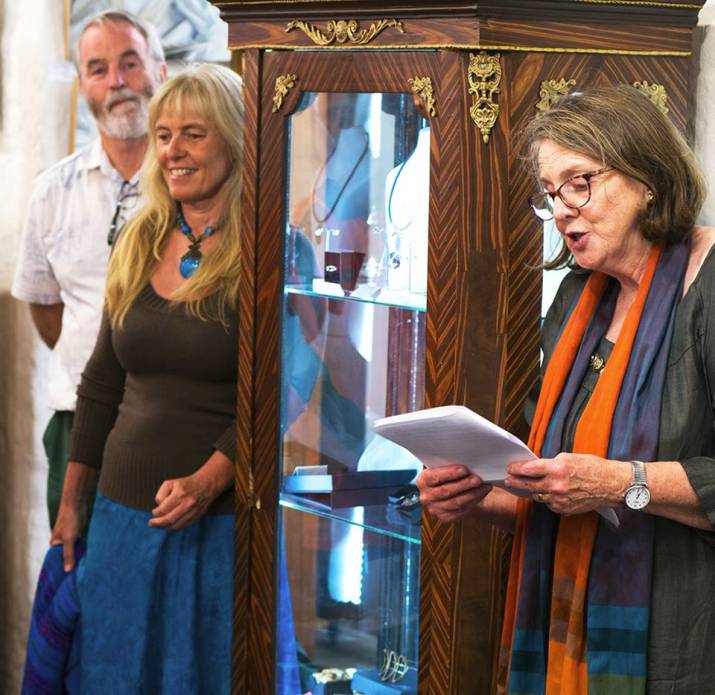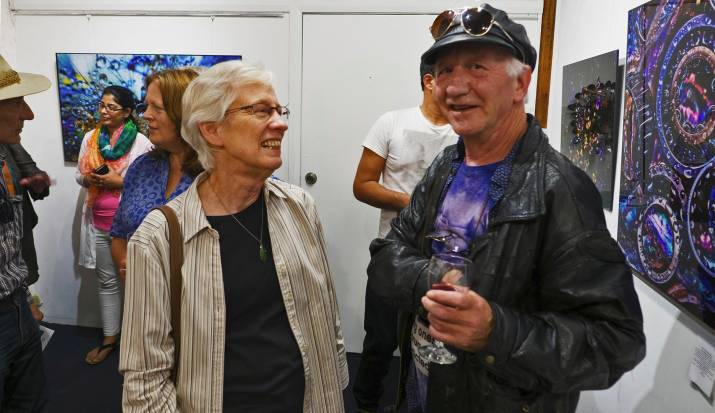
LAUNCH: GILES HUGO'S PHOTOGRAPHIC EXHIBITION
Far away is close at hand (Nolan Gallery, Hobart - 3rd March 2017)
 Good evening everyone and welcome, especially to those who have travelled some way to get here. My name is Anne Kellas and I thank Greg and Betty Nolan of the Nolan Gallery for the opportunity to speak tonight. I will do so in tandem with Betty Nolan, who will talk about Giles Hugo’s photography from an artist’s perspective, whereas I will be talking about Giles the man behind the camera.
Good evening everyone and welcome, especially to those who have travelled some way to get here. My name is Anne Kellas and I thank Greg and Betty Nolan of the Nolan Gallery for the opportunity to speak tonight. I will do so in tandem with Betty Nolan, who will talk about Giles Hugo’s photography from an artist’s perspective, whereas I will be talking about Giles the man behind the camera.
I am a poet, and the processes of photography are somewhat arcane to me even though the smell of darkroom chemicals still lingers in my mind. I have had the privilege of watching Giles’s photographic life develop over the past 40 years, and am so pleased to see him emerge from the dark into the light. He’s come such a long way from the young journalist who landed a front page photo in The Cape Times, to the professional whom you see tonight.
Since his uncle taught him how to use a camera as a child, since he first bought a camera as a very young man, since he bought a Leica in the first year of our marriage – he has been in love with photography. It has been the subtext of our lives. Maybe, maybe, I have never really known how much so until recently. Some know Giles the newspaper sub-editor, Giles the writer and book reviewer. Behind these, there has always been Giles the photographer.
Not only photography, but art in general has played a huge part in his life: his very eccentric British mother was an architect and artist. She introduced him to her friend, Jansje Wissema an architectural photographer famous for her photographs of District Six in Cape Town and the forced removals that made apartheid such an appalling policy. Wissema was also a portrait photographer and I would love to see her photos of those little Hugos of long ago; she was an early influence on his artistic sensibilities.
I could talk in an amusing way about how I am this photographer’s taxi driver (he does not drive), and how, on our way to Radio for the Print Handicapped on cold winter mornings we drove with all the windows open just so he could get a clear view for a street shot, or how he set me up with his camera a few metres away from where he sat on the pavement outside a shop-window of the smartest department store in Johannesburg, dressed as a tramp and begging: it was my role to press the shutter to photograph the faces of the passers-by. I could talk about how our house has cupboardsful of black and white A5 prints, and negatives. Or, how it is a house we bought because he fell in love with the laundry – What a lovely darkroom that would make! he’d said, even as the real estate agent was kicking the tyres and telling us not to buy the house. But we did. At that time, 30 years ago, we ate mostly tinned tuna after migrating here and Giles worked double shifts many days of the week to pay off the mortgage. Buying photographic equipment was a luxury he seldom indulged in. Though indulge in it he did, and I have come to know well the sheepish look with which he approaches me after the event. I have to tell you, I have bought a lens ... Well, what can I say?
The first date Giles and I went on was to an art exhibition, and I soon came to meet a string of previous girlfriends, many of whom were artists: Vita Palestrant was a photographer who introduced him to key South African photo-journalists. He gleaned as much from these friends as he could. Giles is a learning-machine. He absorbs things with his keen mind, a well-trained, disciplined mind that respects knowledge, learning, books, history, and most of all, art. Do read his artist’s statement, on the back of his catalogue, where he cites the influences on his work. Robert Cappa, Robert Mapplethorpe, Henri Cartier-Bresson, Brassaï, Walker Evans, Diane Arbus, and the South African photographer David Goldblatt. Artists he is in love with include Edward Hopper, Turner, Klimpt, Egon Schiele, Georgia O’Keefe, and Andy Warhol.
His credo is a saying of Andy Warhol to Lou Reed: You have to work every day. Giles works every day. Talk about reaching 10,000 hours in your practice – Giles has exceeded that, many times over.
There’s a serious side to him, a depth he seldom talks about. In a time of deep mourning and sorrow Giles turned inwards to his camera, turned inward in to other worlds – he began examining the inky black solar systems in marbled stone, the star-scapes in rock formations, the sky-forms in shells, the cloud-colours in flowers, the ragged rainbows that are bees’ wings, the moon-shadows of belladonna lilies, and most of all, the light of the changing sky. He began to go macro, seeking out life at the level of the barely visible, going deeper and deeper into the see-able, pushing magnification to the max.
He is up at dawn, at work with his camera, climbing my father’s old ladder that he has strapped to the pergola to get onto the garage roof, to see how the clouds lie. The outside poolroom has become a studio where he poses his “models”: dandelions, husks of poppies, strange grasses; spiders which he captures and keeps, for a while, on rock islands moored in basins of water. Like some kind of bower bird, he takes little objects from the house and squirrels them away out there – a favourite cut glass flower vase, tea trays, peacock feathers, silky cloth, anything that serves to create the canvases of the mini-stages with which he paints his scenes. And he patiently shoots, again and again, long into the late morning, through the day, until he gets it right.
At night the process of selection begins. In his small study dominated by two computer monitors, with 60s rock music blaring, and array of memorabilia from a lifetime surrounding him, he works. I have the privilege of looking over his shoulder as he selects work from the day’s dozens and dozens of photographs, but have long since given up saying, I like that one! No, he will say, I could do better…
It is this sense of certainty that defines the accomplished art you see exhibited here tonight.
The key thing I want to tell you about this very gifted – and far too modest man – is that he is very serious about his art. He is utterly dedicated. A solitary man. Getting him to come out of his study and exhibit his work to the public took all the persuasion of friends and family. The affirmation of his art from his son Daniel, who is here tonight, from friends like Lyn Gascoigne, Terry O’Malley, and the encouragement of Tom Staiger, who provided the Nolan Gallery with the massive A0 and A1-sized prints in drawers here for inspection, helped persuade him to mount his first exhibition two years ago. When Giles took his prints around galleries in Hobart, the first two rejected him and this, the third, snapped him up. Betty Nolan will tell you why in a second or two. I agree with her that he is a fine art-maker. A fine-art maker.
 To conclude: I introduce Giles to you as a serious, working photographer with exacting standards. His passion and patience, his persistence and attention, his refined sense of the artistic, the certainty with which he follows his path, these are qualities I do so admire. I recognise in him a rare quality, that which artists of every form share: that ability to take the ordinary, and make it utterly new again. Extraordinary.
To conclude: I introduce Giles to you as a serious, working photographer with exacting standards. His passion and patience, his persistence and attention, his refined sense of the artistic, the certainty with which he follows his path, these are qualities I do so admire. I recognise in him a rare quality, that which artists of every form share: that ability to take the ordinary, and make it utterly new again. Extraordinary.
Anne Kellas is a poet based in Hobart. Born into apartheid South Africa, she lived in England and Swaziland before emigrating to Australia in 1986. She has taught poetry at tertiary level, given poetry workshops, reviewed books, mentored poets, and acted as poetry editor for small presses. Her three books are: Poems from Mt Moono (1989), Isolated States (2001), written with the support of an Arts Tasmania grant, and The White Room Poems (2015), written with the support of an Australia Council grant. Almost all her work has been translated into Ukrainian, with some appearing recently in a Ukrainian anthology of writing. Writers in Australia who have migrated from English-speaking countries are not often thought of as migrants, and Kellas’s themes often address deracination, dislocation and loss. She brings “both wit and deep seriousness to her poetry” with themes that “take up the kind of apocalyptic vision of Doris Lessing” (Kevin Brophy, reviewing Isolated States). Composer Scott McIntyre is busy setting The White Room Poems to music, and in 2008, “A song cycle of poems by Anne Kellas” based on Isolated States was recorded by Matthew Dewey, composer and music director at ABC Classic FM.